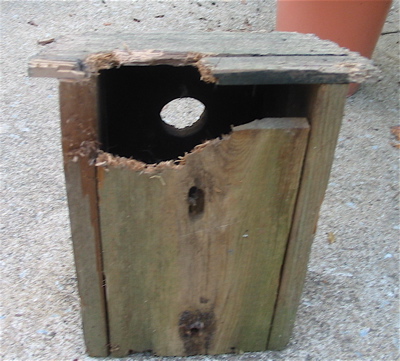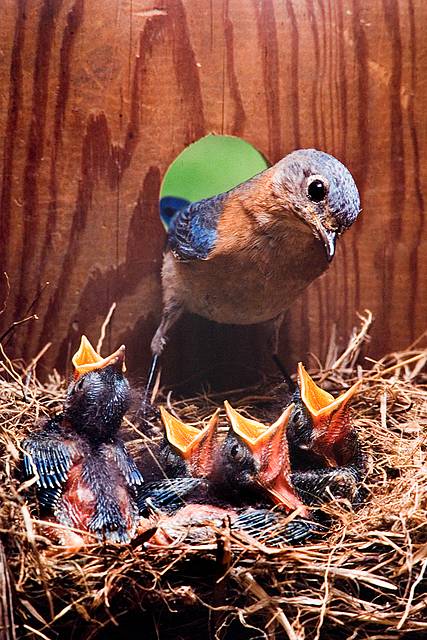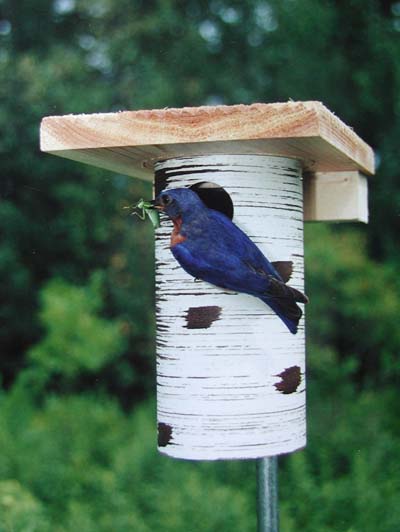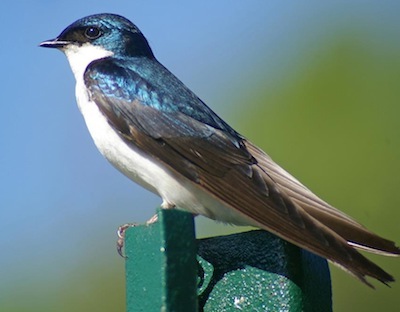-
Friend and Foe Use Bluebird Houses Through Winter
Fairly late and third nesting reports for Eastern bluebirds were common this year, possibly due in part to the previously treacherous winter and their delayed instincts for claiming territories and nest boxes (nest starts).
Now’s a great time to check bluebird houses for repairs and remove nesting materials from the busy spring season. Although bluebirds don’t usually roost in houses… others will! Offering shelter through tough winter months for resident birds is simple if you have a house or two up already. Just clean them out and check for repairs. And a good cleaning is optimal if you have the time, a diluted bleach solution works great. Use a 1:10 ratio of bleach to water and a good scrub brush. Rinse well, let air dry and replace.
Squirrels can do a number on wood birdhouses, especially enlarging the entries to gain access. If the damage isn’t too bad yet, it’s an easy fix by adding a metal or brass portal over the entrance. It’s a good way to save your birdhouses for the birds and deter squirrels through winter. Well… some squirrels anyway!
For the past few years we’ve had a downy woodpecker who claims a bluebird house for nightly roosting, it’s actually pretty cool! House sparrows on the other hand, should be discouraged from roosting in any houses… they’re a major foe of the bluebird and most native cavity nesting birds.
If and when you do go to clean out houses, you may see droppings which will give you a clue as to who’s roosting in there. If they’re white, you can bet house sparrows are in the area. Black droppings with seeds indicates bluebirds. Let’s hope for the latter 🙂
-
Happy Father’s Day from Inside the Blue Bird Houses!
Many males in the winged world also labor in raising their families, so today we salute all of the hard working dads who help raise their kids!
A typical view inside blue bird houses, dad keeps a watchful eye on nestlings, while taking turns with mom bringing food to the babies.
The digs: A male bird’s skill at nest building is a sign of his suitability as a mate; he invests huge effort in the task. Males will build multiple nests to attract females, they’ll continue to build new nests until a female is happy with the construction and chooses one.
The food: Many male birds help raise their families, bringing food home to the babies. Sometimes they even have to incubate the eggs alone or take turns with the female. Male bald eagles, for example, take turns sitting on the eggs as well as bring food home to the young.
Protection: In species where both parents care for the young, the male often gathers food while the female spends more time brooding, keeping the baby birds warm, sheltered and safe from predators.
– Western Bluebirds usually breed in monogamous pairs. By the end of breeding season, most daughters disperse; most sons and the occasional daughter remain with their family for winter. In spring, the yearlings go off and nest on their own, but sometimes one or more sons stay to help their parents. Sometimes a bluebird with his own mate will help at his parents’ nest, while also feeding his own young next door. Source citation: The Cornell Lab of Ornithology
Happy Father’s Day to All~We salute your dedication to family!
-
Tree Swallows Like Blue Bird Houses too
Their migration is underway! Lucky little fliers spend their winters in the Caribbean, Central America, and the Southern-most parts of Texas and California. They’re heading as far north as Alaska and Canada, seeking mates and natural nest cavities or birdhouses to raise their young. Competition for nest sites is brutal… real estate’s tough out there!
Dwindling and disappearing habitat being a major cause, with fewer snags (dead trees) left intact. Non-native birds are also seeking the same nest spots and put up one fierce fight for the right to claim territory. European starlings and house sparrows wreak havoc on tree swallows, purple martins and bluebirds alike. Just ask any landlord, most will have sad tale or two to tell. Many people who offer martin houses or blue bird houses will discourage these aggressive species in order to protect native songbirds.
A favorite house among our “blues” here in the southeast is the Gilbertson Nest Box, and tree swallows will commonly use them as well.
A sturdy vinyl nest box with wood roof, it’s easy to monitor and reasonably priced. You can get one for the bluebirds and one for tree swallows! Just don’t place them too close together. For best results, one in the front and one in the back is a pretty good rule of thumb.
Because all blue bird houses are not created equal, we highly encourage anyone serious about helping bluebirds to use houses approved by The North American Bluebird Society. When you see the acronym NABS… you’ll know!
Celebrate spring and help welcome all migratory friends from their long journeys North!
Nab 10% off site-wide on all bird houses, seed feeders, birdbaths and hummingbird feeders too. And don’t forget the nesting material… we’re giving that away free with all orders through May 15th!
Use promo code MC10
Now Come on spring 🙂






